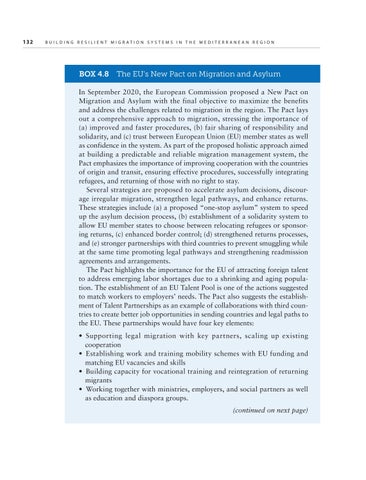132
B U ILDING RESILIENT MIGR A TION S Y STEMS IN T H E MEDITERR A NE A N REGION
BOX 4.8 The EU’s New Pact on Migration and Asylum In September 2020, the European Commission proposed a New Pact on Migration and Asylum with the final objective to maximize the benefits and address the challenges related to migration in the region. The Pact lays out a comprehensive approach to migration, stressing the importance of (a) improved and faster procedures, (b) fair sharing of responsibility and solidarity, and (c) trust between European Union (EU) member states as well as confidence in the system. As part of the proposed holistic approach aimed at building a predictable and reliable migration management system, the Pact emphasizes the importance of improving cooperation with the countries of origin and transit, ensuring effective procedures, successfully integrating refugees, and returning of those with no right to stay. Several strategies are proposed to accelerate asylum decisions, discourage irregular migration, strengthen legal pathways, and enhance returns. These strategies include (a) a proposed “one-stop asylum” system to speed up the asylum decision process, (b) establishment of a solidarity system to allow EU member states to choose between relocating refugees or sponsoring returns, (c) enhanced border control; (d) strengthened returns processes, and (e) stronger partnerships with third countries to prevent smuggling while at the same time promoting legal pathways and strengthening readmission agreements and arrangements. The Pact highlights the importance for the EU of attracting foreign talent to address emerging labor shortages due to a shrinking and aging population. The establishment of an EU Talent Pool is one of the actions suggested to match workers to employers’ needs. The Pact also suggests the establishment of Talent Partnerships as an example of collaborations with third countries to create better job opportunities in sending countries and legal paths to the EU. These partnerships would have four key elements: • Supporting legal migration with key partners, scaling up existing cooperation • Establishing work and training mobility schemes with EU funding and matching EU vacancies and skills • Building capacity for vocational training and reintegration of returning migrants • Working together with ministries, employers, and social partners as well as education and diaspora groups. (continued on next page)

